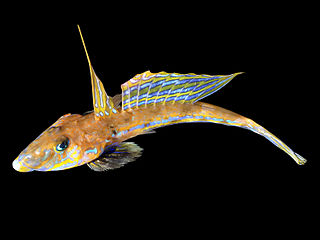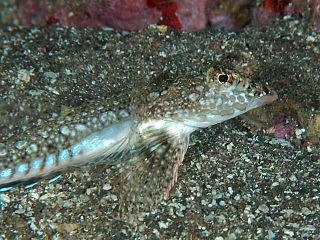
Dragonets are small, percomorph, marine fish of the diverse family Callionymidae found mainly in the tropical waters of the western Indo-Pacific. They are benthic organisms, spending most of their time near the sandy bottoms, at a depth of roughly two hundred meters. There exist 139 species of the fish, in nineteen genera.

Callionymus is a genus of dragonets found mostly in the Indian and Pacific oceans with a few species occurring in the Atlantic Ocean.

The lancer dragonet, Baird's dragonet, coral dragonet or St Helena dragonet, is a species of dragonet native to the warmer waters of the Atlantic Ocean where it occurs at depths of from 1 to 91 metres. In the western Atlantic it occurs from Cape Hatteras southwards along the east coast of North America. including Bermuda and the Bahamas, into the Gulf of Mexico and throughout the Caribbean Sea. It has also been recorded from Ilha da Trindade off Brazil. In the eastern Atlantic it has been recorded from the Cape Verde Islands, Ascension Island, St. Helena, and Sao Tome e Principe in the Gulf of Guinea. This species grows to a length of 11.4 centimetres (4.5 in) TL.
Callionymus belcheri, Belcher's dragonet or the flathead dragonet, is a species of dragonet native to the Pacific Ocean waters off of Australia and Papua New Guinea where it occurs at depths of from 18 to 36 metres.
Callionymus colini, the Tiny New Guinea longtail dragonet, is a species of dragonet endemic to the Pacific Ocean waters around Papua New Guinea.
The ornamented dragonet is a species of dragonet endemic to the waters around the Hawaiian Islands where it occurs at depths of from 3 to 28 metres. This species grows to a length of 3 centimetres (1.2 in) SL.
Callionymus kailolae, Kailola's deepwater dragonet or the Northwestern ocellated dragonet, is a species of dragonet native to the Indian Ocean off of western Australia where this deep-water species is found at depths of from 200 to 204 metres. The specific name honours Patricia Kailola of Newnham, Tasmania who published a photograph of the new species, "in appreciation of her interest in callionymid fish research".
Callionymus leucobranchialis, the Whitegill dragonet, is a species of dragonet found in the Pacific waters around the Philippines at a depth of about 82 metres (269 ft).
Callionymus macclesfieldensis, the Macclesfield dragonet, is a species of dragonet found only on the Macclesfield Bank in the South China Sea where it is found at depths of from 77 to 82 metres. This species grows to a length of 5 centimetres (2.0 in) SL.
Callionymus martinae, Martina's dragonet, is a species of dragonet endemic to the Pacific waters around Taiwan where it occurs at depths of from 73 to 92 metres. The specific name honours Miss Martina Wolf, of Braunschweig, for her "continued interest" in the author's, Ronald Fricke's, studies.
Callionymus oxycephalus, the Red Sea spiny dragonet, is a species of dragonet endemic to the Red Sea.
Callionymus platycephalus, the flathead dragonet, is a species of dragonet endemic to the Pacific waters around the Philippines where it occurs from the surface to 48 metres (157 ft). This species grows to a length of 8.6 centimetres (3.4 in) SL.

The sailfin dragonet is a species of dragonet common in the Eastern Atlantic, where it occurs on the Portuguese coast to as far north as Lisbon and south to Morocco, and also in the northern Mediterranean including the Adriatic, Aegean and Black seas as well as the coastsLebanon and Israel. It occurs on the southern Mediterranean shore as far east as Tunisia Males of this species grows to a length of 14 centimetres (5.5 in) TL while females reach a length of 10 centimetres (3.9 in) TL. In the areas of the Mediterranean where it occurs it is one of the commonest dragonet species, as it is the only species that has been recorded within many protected areas. It is a benthic species which occurs in shallow waters and prefers sandy bottoms down to 100 metres (330 ft). The males are territorial, aggressively defend their territories from other males and like other dragonets this species undergoes complex breeding behaviour which has 4 phases. This starts with courtship, the male and female then form a pair before ascending to the surface where they release eggs and milt. The spawning season runs from May to August in the Mediterranean and the eggs and larvae are pelagic. This species feeds mainly on small benthic invertebrates such as worms and small crustaceans.

The arrow dragonet, also known as the arrow-headed darter dragonet, is a species of dragonet widespread in the Indo-West Pacific from Arabian Peninsula to the Philippines. Occurs in the Mekong delta of Viet Nam and probably also in Cambodia. This species grows to a length of 11 centimetres (4.3 in) TL. The arrow dragonet is a demersal species, which occurs on sandy substrates along coastlines, in estuaries, and in the lower courses of rivers where it feeds on worms, zooplankton and phytoplankton.
Callionymus whiteheadi, Whitehead's deepwater dragonet, is a species of dragonet found in the Pacific waters around Indonesia. The specific name honours the ichthyologist Peter James Palmer Whitehead (1930-1992).
The Kai Island deepwater dragonet is a species of dragonet native to the Indian Ocean and the western Pacific Ocean, from Zanzibar and the coast of East Africa to the western Pacific Ocean including southern Japan, the East China Sea and the Banda Sea. It is the only species in the monotypic genus Bathycallionymus. This species was formally described in 1880 as Callionymus kaianus by the German-born British zoologist Albert Günther with from a type collected off Kai Island in the Banda Sea during the Challenger expedition of 1872–1876. Some authorities still place this fish in the genus Callionymus.

Calliurichthys is a subgenus of Callionymus, a genus dragonets, native to the western Pacific Ocean. Some authorities consider it to be a valid genus.
Callionymus alisae is a species of dragonet which was described in 2016 from a male specimen collected by a grab dredge as a depth of 90-228 m, southwest of Kavieng, New Ireland, Papua New Guinea. The specimen is yellowish in colour, becoming darker towards the tail and white on the underside, it has dark blue eyes and greyish spots on its body. It was named after the French research vessel which collected the only specimen known so far, the R.V. Alis.

Callionymus izuensis, the Izu dragonet, is a species of dragonet which is endemic to the waters around the Izu Islands of Japan. It is found at depths of 16–18 metres (52–59 ft) over substrates consisting of coarse sand, although sometimes coral rubble and broken shells may form part of the habitat. It was originally described as a subspecies of Callionymus persicus from the western Indian Ocean and has also been placed in the genus Calliurichthys by some authorities.
Synchiropus corallinus, the exclamation point dragonet, is a species of fish in the family Callionymidae, the dragonets. It is found in the Pacific Ocean.






